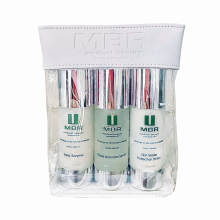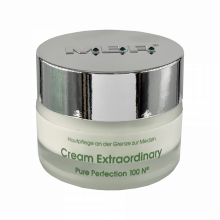Telomeres - Biological Clock
In principle, bacteria can live forever. If a bacterial cell is housed in good conditions, it will continue to divide and increase in size indefinitely. Cells of higher organisms like birds or mammals work slightly differently. Until the middle of the 20th century, it was believed that cells in all species could also live forever. However, in 1912, a scientist at the Rockefeller Institute named Alexis Carrel performed a study designed to study the length of time a chicken fibroblast would divide for. Fibroblasts are the cells of the connective tissue that increase the strength of the three-dimensional framework that is the main support of other cells. Carrel fed the cells a broth that was made from chicken embryos, feeding them regularly. Excess cells were discarded periodically. The fibroblasts continued to divide for years without any sign of slowing until 30 years later, when the experiment was ended (after Carrel's death). It showed that in a specially controlled environment, the cells of higher organisms could also be immortal.
It took until the 1960s for a study that conflicted with Carrels' results to be done. Leonard Hayflick's study of human fibroblasts, maintained in a similar set of conditions to those of Carrel, would only divide about 50 times and then cease. So which one had the more valid methods? Unfortunately, it seems that it was Carrel's experiment was a flawed one. Because the nourishing broth that he used to feed the cells had a low-level content of chicken fibroblasts, he was inadvertently adding new cells regularly. This problem was resolved by Hayflick, who showed that there was a maximal number of divisions that a cell could make in controlled conditions; this came to be known as the Hayflick limit.
The Hayflick limit can be considered a genetic program limiting the number of times a cell can divide. The reason for this limitation is that it reduces the likelihood of uncontrolled cell growth that can result in cancer. Several studies have shown that the genetic clock doesn't have a time limit in cancer cells, thus allowing the cells to divide indefinitely.
Over time, the reason for the Hayflick limit was discovered. Chromosomes in higher organisms are capped with telomeres which are a special kind of DNA structure. The primary purpose of the telomeres is to prevent the ends of the chromosomes from degenerating. The process of DNA replication is what happens when the chromosomes are duplicated through cell division. Due to the way this process works, the tips of the telomeres cannot be effectively replicated. This means that the telomeres grow progressively shorter after each time the cell divides. It seems that once the cells' telomeres have reached a certain length, the cell ceases to be able to divide. (This isn't the case in bacteria because they have circular cells that do not include telomeres). After approximately 50 divisions, the fibroblasts cease to be able to divide by them and take on a different "look" and behavior. The metabolic rates of the fibroblasts slow down; they grow in size and also accumulate lipofuscin, which is the pigment that causes age spots. This is known as cellular senescence.
Products preserving fibroblasts
Could aging be explained as what happens once cells have reached the Hayflick limit and can no longer divide? Unfortunately, there is no conclusive answer to that question at this time. However, it seems that in certain tissues, including the skin and the lining of blood vessels, the Hayflick limit may be a key to the aging process. An example is the increased advancement of vascular diseases with age, which might be partly caused by vascular epithelial cells' decreased ability to divide. The Hayflick limit may also be a factor in age-related changes to the skin as an increased number of dermal fibroblasts attain the state of senescence. Yet interestingly, the brain cells, as well as cells in the nerves, muscles, and retina, do not normally divide, which means that they would not reach the Hayflick limit.
The Hayflick limit does not apply to all cells. Germ cells (the cells that turn into ova or sperm) and cancer are obviously immortal. Embryonic stem cells (and possibly some adult stem cells) also have the potential to be long-lived or even immortal. When a store of immortal stem cells is present in certain tissues (such as skin), the buildup of dysfunctional cells that reaches the Hayflick limit seems to be a problem. Most cells do not die when they reach the Hayflick limit; rather, they enlarge and lose the majority of their practical functions. They are also slow and can cause problems with younger cells. For example, it has been observed that the skin of older people has three times as many senescent fibroblasts as that of younger people. The accumulation of senescence and its resulting loss of capacity can affect several different tissues.
There is a way to override the Hayflick limit. Certain mutations in cancer cells do indeed override the Hayflick limit. Certain viruses have a similar effect. These viruses include the papillomavirus that immortalizes the cells that it infects. A cellular mechanism that overrides the Hayflick limit has been discovered. There is a particular gene that encodes an enzyme (telomerase) that has the ability to restore shortened telomere. The cells in which telomerase has had an effect appear to be immortal. Most normal cells have a more suppressed telomerase activity which keeps them from dividing beyond a certain limit. Scientists have discovered that the Nanog gene is activated in embryonic stem cells, thus making them immortal. INKa is another gene that is an active part of senescence. INKa's role is to encode the P16 protein, which helps prevent cancer by inducing cellular senescence. Mice that have P16 were proven to have fewer senescent cells than there are in regular mice. The tissues of these mice have more regenerative capacity with age. At the same time, the mice with less P16 had a reduced lifespan due to a higher rate of cancer.
The Hayflick limit affects age-related changes and certain tissue-based diseases (primarily based on the blood and skin). Eradicating the Hayflick limit would cause increase the possibility of cancer. It also seems that the number of times a cell dives before it hits the limit is not prescribed. Various environmental factors can accelerate or retard the cellular clock. Raised levels of free radical formation have been proved to shorten the Hayflick limit. Other substances have been shown to extend the limit in certain types.
How can the effect of the cellular clock be minimized when it comes to the aging process? Research is beginning to show that we will be able to use genetic engineering to alter the system that produces the Hayflick limit. This is still in the experimental stages, and the problem with it at the moment is that it seems that the side effects would be an increased possibility of cancer. Scientists are also looking into a way to remove senescent cells from the tissues without causing any residual damage. At the moment, all that we can do is avoid unnecessary cell division. Avoiding these cell divisions can be done by lowering exposure to the factors that cause it. All kinds of cellular stress and tissue damage can result in cell division. This is particularly true of free radicals, inflammation, mutagens, certain toxins, and UV radiation, all of which have been proved to raise levels of cell division. Antioxidants appear to have the opposite effect. Garlic extract might be a regular everyday substance that can limit the Hayflick limit to a small extent. More clinical studies are required to prove its practical effects.



